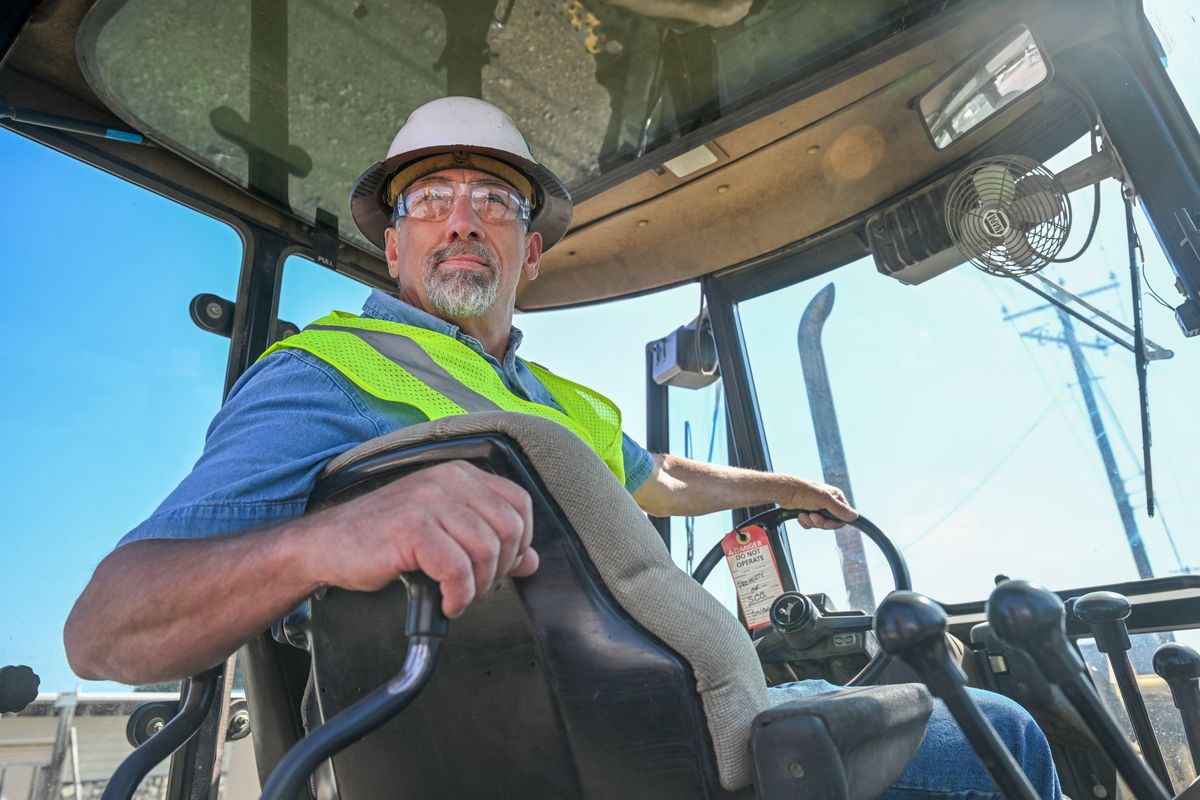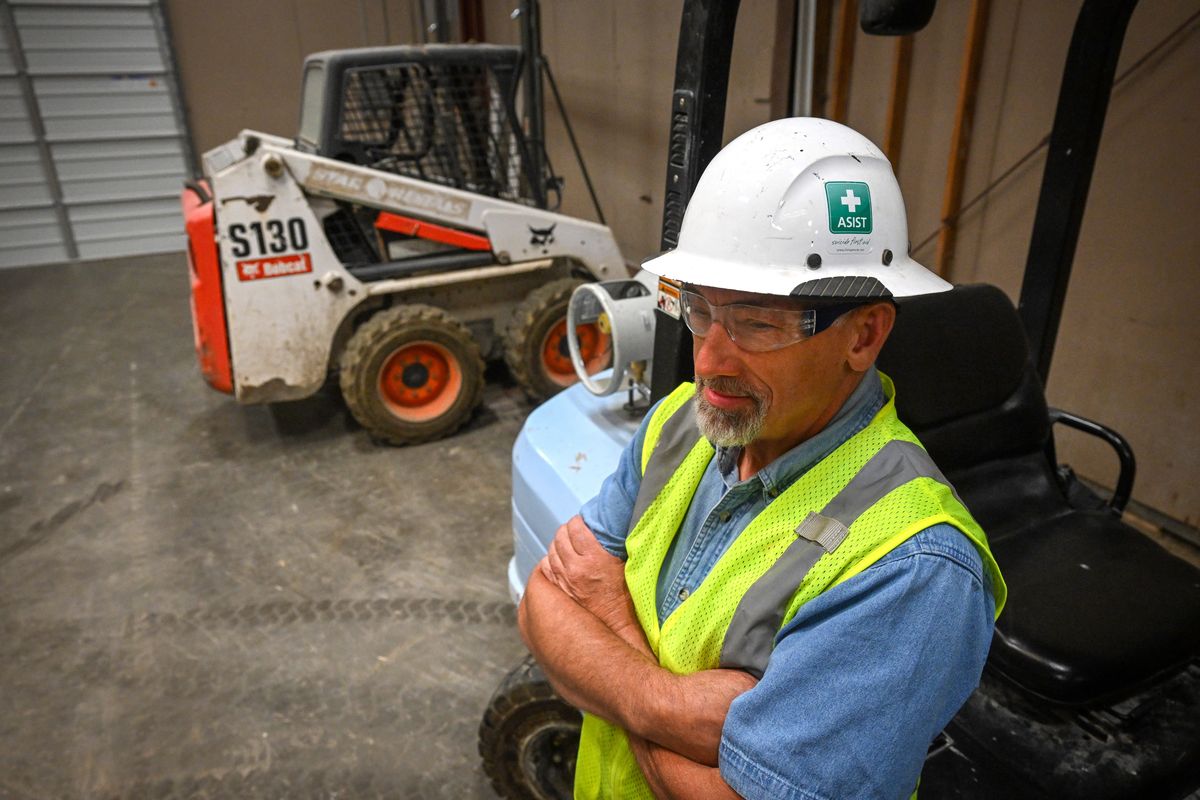Construction workers are at a higher risk of suicide; a local man is making it his mission to intervene
Bert Rohrbach works with young construction workers in training at the Inland Northwest AGC Training Center in East Spokane, shown Thursday. Rohrbach has been trained to talk with people who are contemplating suicide. (Jesse Tinsley/THE SPOKESMAN-REVIEW)
After decades in construction, Bert Rohrbach two years ago found the right tools to help a coworker struggling with mental health.
Rohrbach finds it difficult to talk about three close coworkers who died by suicide since 2014: an electrician, a lowboy truck driver and a young welder who was a “very dear friend.”
Now, he realizes that awareness is needed. The losses happened either when he wasn’t around them or before he knew to notice signs, ask direct questions and use intervention tools.
“Yes, I’ve been impacted by suicide,” said Rohrbach, 67. He worked in heavy equipment, concrete and carpentry for 51 years. “I knew these people. They were real – not just a statistic, not just a number.”
The Inland Northwest Chapter of the Associated General Contractors of America has heightened suicide prevention and mental health supports since 2021 alongside a national effort against the industry’s high suicide rate. Rohrbach is a chapter apprenticeships education director for the organization.
The numbers are significant.
For every 100,000 male construction workers in the U.S., the rate was about 56 suicides annually in 2021, according to the Centers for Disease Control and Prevention. That compares with 32 suicides per 100,000 men in the general population.
In the state, the most recent numbers are from 2018. That year, there were six construction site fatalities such as from falls or accidents, compared with 130 suicides among construction workers in the state, said Shannen Talbot, AGC chapter marketing and communications director.
In 2022, Rohrbach and six others with AGC completed Applied Suicide Intervention Skills Training, better known as ASIST. It’s available to any person or group through FailSafe for Life, a Spokane nonprofit. The AGC members now wear the ASIST logo sticker on safety helmets, so people see them as a resource.
Using strategies he learned, Rohrbach earlier this summer coached an intervention that ended safely for a construction worker who had planned his suicide.
He said that while a majority of construction workers do well over long careers, the profession can have challenges.
“The construction industry appeals to people who like to work hard, like adventure,” Rohrbach added. “It pays well. It has great attraction to people who don’t like repetition. There are also some challenges in that you make really good money, and between jobs, you don’t. Finances and learning to manage finances add to the stresses. The other thing that happens is, it’s hard work, and aches and pains come into play.”
Rohrbach said the 35-year-old welder he knew who died had worked for him. When he died in 2016, they were co-teaching at an Idaho high school technical skills site.
“He had some injuries in the past,” Rohrbach said. “Tragic but true, he went from prescription pain control to off-the-street pain control, which led to an addiction.”
It’s not uncommon.
“Even though we test for that, it’s a very real part for some, but not everybody.”
Other factors include isolation in long hours or at remote sites away from family.
The industry also has large populations of middle-aged men and veterans, both suicide risk groups, along with younger adults in apprenticeships. In 2019, a man died by suicide soon after his local apprenticeship graduation.
In 2014, Rohrbach said it took days before he and others learned their electrician coworker took his life. The lowboy truck driver who died by suicide in 2023 was 60, and a former military fighter pilot. Rohrbach knew him for 30 years, but they hadn’t crossed paths recently.
“He had kicked cancer, so in terms of battles personally fought and service to country – you think – this guy is tough,” Rohrbach said. “Then there’s having some bumps with a relationship, life and aging.”
Rohrbach said he’s starting to see a shift away from that tough, leave-them-alone image.
“The reality is, we work 12 to 14 hours a day with these guys. We can see when the behaviors are changing, when they pull in, when they start to give away their tools, when the depression hits. It’s the tip of the iceberg, but we’re starting to create an understanding that this isn’t somebody else’s problem. It’s ours.
“I live with the guilt of not recognizing that before. The welder – I call him a kid but he was 35 – was right across the classroom from me. We shared students. We had lunch together. We worked together for years. I knew he was having a tough time, but I didn’t ask the right questions.”
Rohrbach said the two-day 2022 session changed that. It had role-playing and simple steps, easier to apply than his training as a former flight medic.
The first step is knowledge and noticing behavior changes.
“I learned that this is a transitional or temporary state of the mind, and like any organ that’s not doing well or struggling, the brain has that similar characteristic.”
Next steps include “I care” actions and direct questions, including to ask whether the person has thought about suicide.
“Then, ‘I’m going to stay with you, we’re going to call the 988 hotline, we’re going to get you to a supervisor who is trained,’ ” he said. “The third step is we get them to a place that’s safe, whether with a counselor or an intervention person.”
The 988 Suicide & Crisis Lifeline has expanded as a tool he and others can text or call for someone, Rohrbach added.
More contractors are posting 988 information at job sites, Talbot said. Soon after the 2022 training, five of the seven AGC members reported they’d led or supported successful interventions in suicide prevention.
The chapter also created mental health resources through its Construction, Culture, Committee, or C3 program, with online tools. The AGC is a trade association for commercial contractors. Talbot said the local chapter has about 400 companies employing thousands of people, from the Tri-Cities up to Spokane and into North Idaho.
Talbot joined an AGC of America mental health national task force in 2022. At all levels, the organization is doing more “to make mental health and suicide prevention a fundamental aspect of every safety program of the companies that work with us,” she said.
It takes courage to ask, Rohrbach added, but it made a difference each time he has.
“What I have learned after asking tough questions and changing how to approach it is that one of two things happens,” he said. “The person says, ‘Yeah I’ve got a plan,’ and then we go to step two, or they say, ‘Bert, no, that’s not my game plan at all, but thanks for checking on me.’
“That’s the maturity, that’s the mindset, that’s the delivery we want to see in construction. That needs to be the new norm.”

